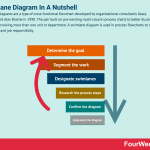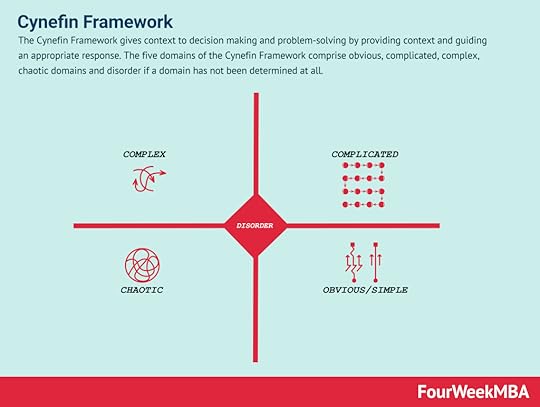What Is A Swimlane Diagram? Swimlane Diagram In A Nutshell

Swimlane diagrams are a type of cross-functional flowchart developed by organizational consultants Geary Rummler and Alan Brache in 1990. The pair built on pre-existing multi-column process charts to better illustrate processes involving more than one unit or department. A swimlane diagram is used in process flowcharts to clarify job sharing and job responsibility.
Understanding swimlane diagramsSwimlane diagrams differ from conventional flowcharts in that processes and decisions are visually grouped into lanes using parallel lines. Each lane in turn represents a single person, group, sub-process, department, or information system.
Directional arrows then cross swimlanes to depict how information or materials move through the various sub-processes, providing clarity on the departments or employees responsible for a particular set of actions.
Like a conventional flowchart, however, swimlane diagrams use directional arrows to represent the sequence of events in an overall process from start to finish.
Businesses use swimlane diagrams to:
Identify bottlenecks, delays, redundancies, and extraneous steps to streamline processes.Standardize work processes and then document them in a format that is easily shared and simple to understand.Ensure all necessary parties are involved in a process, andIncrease operational transparency and collaboration between departmentsCreating a swimlane diagram
Creating a swimlane diagram is a matter of following a few simple steps:
Determine the goal – this enables the business to identify what process or processes need to be analyzed. What level of detail is required for there to be a sufficient level of understanding?Segment the work – break the process down into its constituent parts and clearly identify the boundaries of the process to be studied. Designate swimlanes – as noted earlier, these may be departments, groups, employees, or information systems.Research the process steps – this is achieved by laying out the interconnectedness between each lane. It’s important to start by documenting the process as it exists and then looking for process gaps, redundancies, or duplicated steps. Swimlane diagrams can be hand-drawn or created using software such as Microsoft Word and Microsoft PowerPoint. Whatever the method chosen, use standard symbols to depict each process step sequentially in its associated swimlane.Confirm the diagram – consult with individuals who are familiar with the process, and make adjustments where necessary.Implement the diagram – this may involve incorporating the diagram into a new standard operating procedure or as a reference tool for quality or training purposes. Alternatively, new diagrams can be devised for the same process to compare various approaches and choose the best way forward.Key takeaways:A swimlane diagram is used in process flowcharts to clarify job sharing and job responsibility. These flowcharts were developed by organizational consultants Geary Rummler and Alan Brache in 1990.A swimlane diagram is used to streamline processes, delineate roles and responsibilities, and increase transparency and collaboration between related departments.A swimlane diagram can be hand-drawn or created using flowchart software. Businesses must first determine a goal and work backward to identify the process steps required to achieve it. Those familiar with the process should be consulted before it is accepted into standard operating procedures or training.Connected Business FrameworksCynefin Framework The Cynefin Framework gives context to decision making and problem-solving by providing context and guiding an appropriate response. The five domains of the Cynefin Framework comprise obvious, complicated, complex, chaotic domains and disorder if a domain has not been determined at all.SWOT Analysis
The Cynefin Framework gives context to decision making and problem-solving by providing context and guiding an appropriate response. The five domains of the Cynefin Framework comprise obvious, complicated, complex, chaotic domains and disorder if a domain has not been determined at all.SWOT Analysis A SWOT Analysis is a framework used for evaluating the business’s Strengths, Weaknesses, Opportunities, and Threats. It can aid in identifying the problematic areas of your business so that you can maximize your opportunities. It will also alert you to the challenges your organization might face in the future.Pareto Analysis
A SWOT Analysis is a framework used for evaluating the business’s Strengths, Weaknesses, Opportunities, and Threats. It can aid in identifying the problematic areas of your business so that you can maximize your opportunities. It will also alert you to the challenges your organization might face in the future.Pareto Analysis The Pareto Analysis is a statistical analysis used in business decision making that identifies a certain number of input factors that have the greatest impact on income. It is based on the similarly named Pareto Principle, which states that 80% of the effect of something can be attributed to just 20% of the drivers.Failure Mode And Effects Analysis
The Pareto Analysis is a statistical analysis used in business decision making that identifies a certain number of input factors that have the greatest impact on income. It is based on the similarly named Pareto Principle, which states that 80% of the effect of something can be attributed to just 20% of the drivers.Failure Mode And Effects Analysis A failure mode and effects analysis (FMEA) is a structured approach to identifying design failures in a product or process. Developed in the 1950s, the failure mode and effects analysis is one the earliest methodologies of its kind. It enables organizations to anticipate a range of potential failures during the design stage.Blindspot Analysis
A failure mode and effects analysis (FMEA) is a structured approach to identifying design failures in a product or process. Developed in the 1950s, the failure mode and effects analysis is one the earliest methodologies of its kind. It enables organizations to anticipate a range of potential failures during the design stage.Blindspot Analysis A Blindspot Analysis is a means of unearthing incorrect or outdated assumptions that can harm decision making in an organization. The term “blindspot analysis” was first coined by American economist Michael Porter. Porter argued that in business, outdated ideas or strategies had the potential to stifle modern ideas and prevent them from succeeding. Furthermore, decisions a business thought were made with care caused projects to fail because major factors had not been duly considered.
A Blindspot Analysis is a means of unearthing incorrect or outdated assumptions that can harm decision making in an organization. The term “blindspot analysis” was first coined by American economist Michael Porter. Porter argued that in business, outdated ideas or strategies had the potential to stifle modern ideas and prevent them from succeeding. Furthermore, decisions a business thought were made with care caused projects to fail because major factors had not been duly considered.Main Free Guides:
Business ModelsBusiness StrategyBusiness DevelopmentDigital Business ModelsDistribution ChannelsMarketing StrategyPlatform Business ModelsTech Business ModelThe post What Is A Swimlane Diagram? Swimlane Diagram In A Nutshell appeared first on FourWeekMBA.



